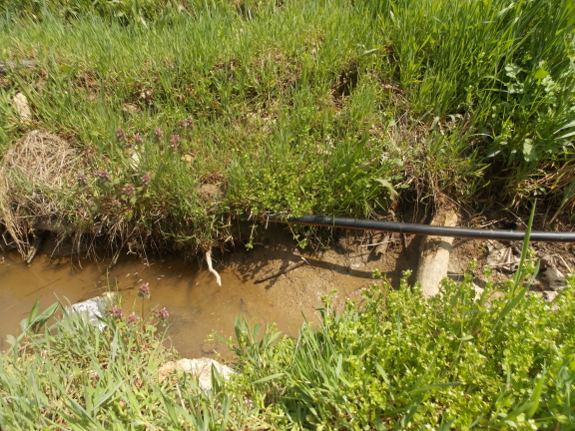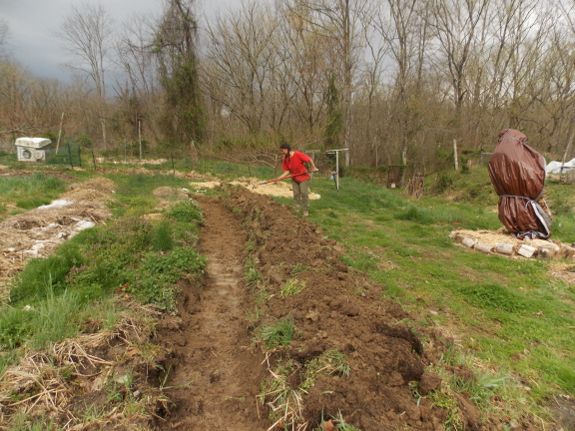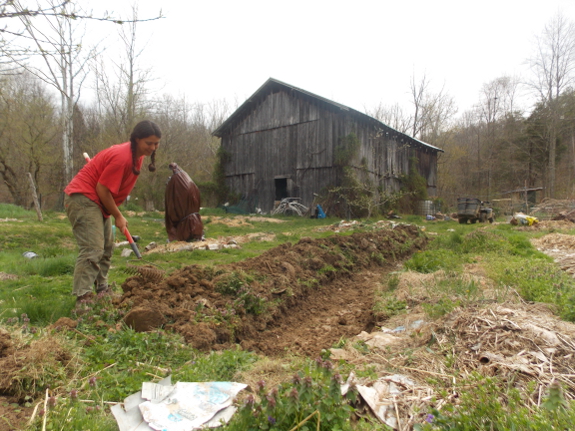
Small-scale chinampas

 As one of our readers commented, my terraforming project created tiny chinampas. All winter, the rye
I sowed on the raised parts of the beds thrived despite the soggy
aisles, and come spring, wildlife moved into the little ponds between
the beds. I found two baby snapping turtles hanging out in the
shallow water this weekend, and plenty of tadpoles are escaping their
eggs to join in the fun.
As one of our readers commented, my terraforming project created tiny chinampas. All winter, the rye
I sowed on the raised parts of the beds thrived despite the soggy
aisles, and come spring, wildlife moved into the little ponds between
the beds. I found two baby snapping turtles hanging out in the
shallow water this weekend, and plenty of tadpoles are escaping their
eggs to join in the fun.
As long-time readers will
realize, we struggle to deal with the wet ground in certain parts of
our garden, so seeing how well these little chinampas do has been an
eye-opening experience. I decided to go ahead and dig the back
garden into similar raised beds to ensure that this year's tomatoes
don't suffer from wet feet.

You'll know if your soil
is wet enough to need small-scale chinampas because rushes and sedges
will be growing in the mown aisles along with grass. To confirm
that the groundwater is too high for the soil to be planted into as-is,
dig around a clump of earth, then grab the grass on top as if lifting
the clump up by its hair. If the soil is well-drained, the whole
clump will stay together since roots go straight down into the
subsoil. If the soil is waterlogged, the top will peel off since
the plant roots stayed in the inch or two of soil above the water.

I dug one long chinampa
Monday, which is about all my wrists can take before they start to
complain. I mostly tried to place the sod grass-side down so it
will rot quickly, but I wasn't all that particular about it, knowing
that I can always lay down some cardboard over top before transplanting
in my tomato sets.
Of course, the down-side
of turning the garden into chinampas is that I may be walking through an
inch or two of water in the aisles if the summer is wet. But
better my feet get wet than my tomatoes complain! Plus, if the
aisles turn into ponds, they won't have to be mowed, right?
Want more in-depth information? Browse through our books.
Or explore more posts by date or by subject.
About us: Anna Hess and Mark Hamilton spent over a decade living self-sufficiently in the mountains of Virginia before moving north to start over from scratch in the foothills of Ohio. They've experimented with permaculture, no-till gardening, trailersteading, home-based microbusinesses and much more, writing about their adventures in both blogs and books.
Want to be notified when new comments are posted on this page? Click on the RSS button after you add a comment to subscribe to the comment feed, or simply check the box beside "email replies to me" while writing your comment.

Daniel --- I did put punky wood in the swales in the forest pasture, but that's because I won't be walking there much. I want to be able to walk and run a wheelbarrow through these aisles, frequently, so nothing bulky can go there. If I had spare wood chips, they would be perfect, but I never even have enough of those to mulch the fruit trees, let alone "waste" in aisles....
Brian --- I'm probably going to wait until our frost-free date to uncover our figs. Last year, I uncovered them earlier, they leafed out, and then they got nipped....
Mom --- Glad you enjoyed it! I don't know enough about whether tomatoes were a big part of their gardens at that time to answer your question, unfortunately.
Roland --- It's always a tradeoff with blight around here. My best results have come from putting plants in the sunniest part of the yard so anything that splashes up dries quickly. Of course, if I had a spot that was sunny and had well-drained soil, that would be even better, but the choices are wet soil and sun or dry soil and shade, so I chose the former.
If wet aisles do become a problem, instead of all the work involved with schleppin' around wood chips, etc, just wear galoshes.
To put drainage problems in perspective, I've read that American farm production would be increased by 25% if all farmers made complete & proper use of drain tiles!
Anna, what is the difference (guess I cold have wiki'd it) between this fancy 9 lettered "chinampas" and a good 'ol fashioned "Ditch" (five letters)?
I can recall my youth, I could have told my dad I "put the car in a chinampas" and maybe he would have been less mad than he was as I put my car in the "ditch" that winter night I went out despite his advisement.